Which of the following is an example of a storage form of glucose in the human body?
A. Starch
B. Glycogen
C. Fructose
D. Cellulose
Glycogen is the storage form of glucose in the human body.
It is a polysaccharide that is stored primarily in the liver and muscle tissue and can be broken down into glucose when the body needs energy.
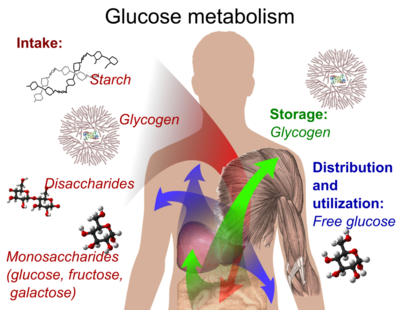 |
Choice A is incorrect because starch is a storage form of glucose in plants, not in the human body.
Choice C is incorrect because fructose is a simple sugar, not a storage form of glucose.
Choice D is incorrect because cellulose is a structural carbohydrate found in plant cell walls, not a storage form of glucose in the human body.
Therefore, the Correct Answer is B.
More Questions on TEAS 7 Science
-
Q #1: What is the function of the neuromuscular junction?
A. To connect muscle fibers to motor neurons
B. To bind acetylcholine to nAChRs
C. To depolarize the muscle cell membrane D.
D. To activate voltage-gated sodium channels on the muscle membrane .
Answer Explanation
The neuromuscular junction is a type of synapse where neuronal signals from the brain or spinal cord interact with skeletal muscle fibers, causing them to contract.
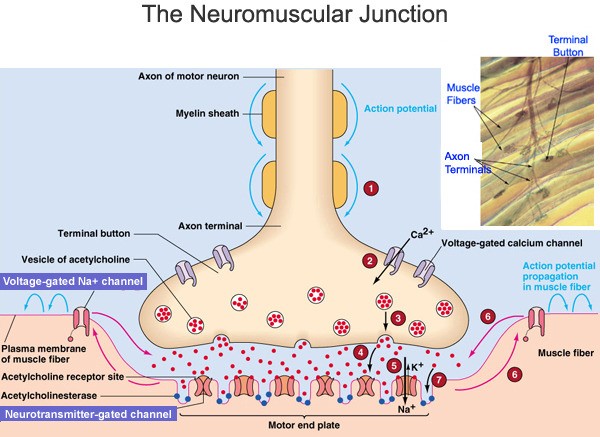
The activation of many muscle fibers together causes muscles to contract, which in turn can produce movement.
Choice B is incorrect because binding acetylcholine to nAChRs is a process that occurs at the neuromuscular junction, but it is not the function of the neuromuscular junction itself.
Choice C is incorrect because depolarizing the muscle cell membrane is a result of the function of the neuromuscular junction, but it is not the function itself.
Choice D is incorrect because activating voltage-gated sodium channels on the muscle membrane is a result of the function of the neuromuscular junction, but it is not the function itself.
-
Q #2: Which of the following structures in the nephron is responsible for reabsorbing ions, water and nutrients?
A. Distal tubule
B. Proximal tubule
C. Glomerulus
D. Loop of Henle
Answer Explanation
Proximal tubule
The proximal tubule is responsible for reabsorbing all the nutrients and most of the water.
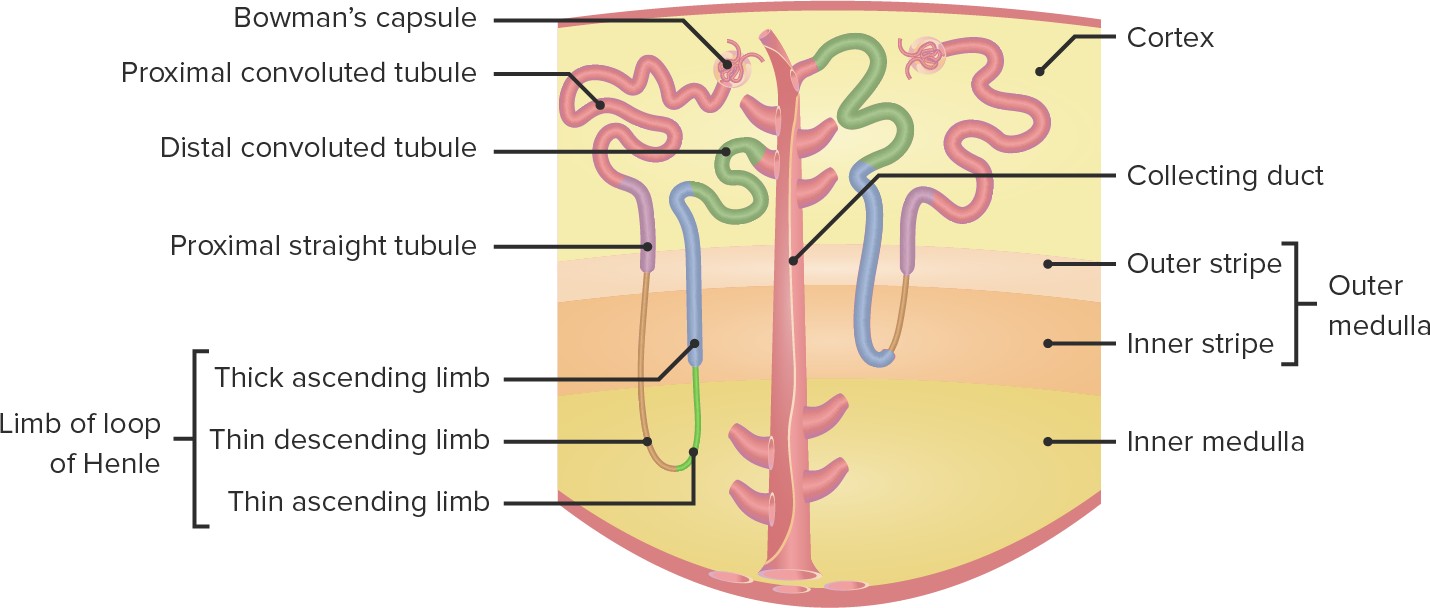
Choice A is incorrect because the distal tubule is not primarily responsible for reabsorbing ions, water and nutrients.
Choice C is incorrect because the glomerulus is responsible for filtering fluid and solutes out of the blood to form a glomerular filtrate.
Choice D is incorrect because the Loop of Henle is not primarily responsible for reabsorbing ions, water and nutrients.
-
Q #3: What is a primer in DNA sequencing?
A. A short piece of double-stranded DNA that binds to the template DNA and acts as a "starter" for the polymerase.
B. A short piece of double-stranded DNA that binds to the primer and acts as a "starter" for the template.
C. A short piece of single-stranded DNA that binds to the template DNA and acts as a "starter" for the polymerase.
D. A short piece of single-stranded DNA that binds to the polymerase and acts as a "starter" for the template.
Answer Explanation
A primer is a short single-stranded DNA fragment used in certain laboratory techniques, such as the polymerase chain reaction (PCR).
In the PCR method, a pair of primers hybridizes with the sample DNA and defines the region that will be amplified.

Choice A) A short piece of double-stranded DNA that binds to the template DNA and acts as a “starter” for the polymerase is incorrect because primers are single-stranded, not double-stranded.
Choice B) A short piece of double-stranded DNA that binds to the primer and acts as a “starter” for the template is incorrect because it does not make sense for a primer to bind to itself.
Choice D) A short piece of single-stranded DNA that binds to the polymerase and acts as a “starter” for the template is incorrect because primers bind to the template DNA, not to the polymerase.
Note: DNA primers are used instead of RNA primers in DNA sequencing and PCR because DNA is more stable, specific, and compatible with the enzymes and processes involved in these techniques.
-
Q #4: During the menstrual cycle, which structure in the ovary produces progesterone to prepare the endometrium for potential implantation?
A. Corpus luteum.
B. Fimbriae
C. Follicle
D. Ovarian ligament.
Answer Explanation
Corpus luteum.
During the menstrual cycle, the corpus luteum in the ovary produces progesterone to prepare the endometrium for potential implantation.

Choice B is incorrect because fimbriae are finger-like projections at the end of the fallopian tubes that help guide the egg into the tube.
Choice C is incorrect because a follicle is a sac in the ovary that contains an immature egg.
Choice D is incorrect because the ovarian ligament is a fibrous band of tissue that connects the ovary to the uterus.
-
Q #5: Which of the following hormones is responsible for regulating the body's metabolism and energy levels?
A. Estrogen
B. Progestin
C. Thyroxine
D. Androgen
Answer Explanation
The correct answer is choice C. Thyroxine.
Thyroxine (T4) is a hormone produced by the thyroid gland that controls your body’s metabolism, the process in which your body transforms the food you eat into energy.
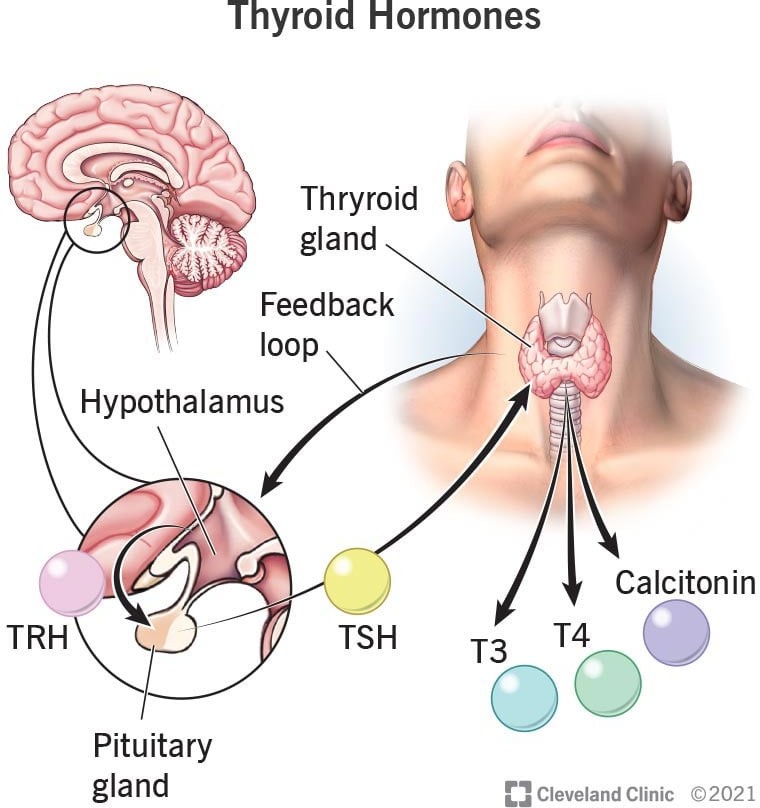
Choice A, Estrogen, is not the correct answer because it is a hormone responsible for the development of female secondary sexual characteristics.
Choice B, Progestin, is not the correct answer because it is a synthetic form of progesterone used in hormonal birth control and hormone replacement therapy.
Choice D, Androgen, is not the correct answer because it is a hormone responsible for the development of male secondary sexual characteristics.
-
Q #6: Which of the following is a mechanism that the body uses to regulate blood pH levels?
A. Increased respiration rate to remove excess CO2.
B. Decreased respiration rate to retain CO2.
C. Increased water intake to dilute the blood.
D. Decreased water intake to concentrate the blood.
Answer Explanation
The correct answer is choice A.
Increased respiration rate to remove excess CO2.
The body regulates blood pH through several mechanisms, including chemical buffers, the respiratory system, and the urinary system.
The respiratory system can adjust blood pH by changing the rate of respiration to remove or retain CO2.
When there is excess acid in the blood, the respiratory rate increases to remove more CO2, which helps to raise blood pH.
Choice B is incorrect because decreasing the respiration rate would retain CO2, which would lower blood pH.
Choice C is incorrect because increased water intake would not directly affect blood pH levels.
Choice D is incorrect because decreased water intake would not directly affect blood pH levels.
-
Q #7: What is hydrogen bonding?
A. The attraction between the relatively positive areas of one molecule and the relatively negative areas of another molecule.
B. The repulsion between the positive and negative charges of two molecules.
C. The attraction between two nonpolar molecules.
D. The attraction between two ionic molecules.
Answer Explanation
Hydrogen bonding is an interaction involving a hydrogen atom located between a pair of other atoms having a high affinity for electrons.

One atom of the pair (the donor), generally a fluorine, nitrogen, or oxygen atom, is covalently bonded to a hydrogen atom, whose electrons it shares unequally; its high electron affinity causes the hydrogen to take on a slight positive charge.
The other atom of the pair (the acceptor), also typically F, N, or O, has an unshared electron pair, which gives it a slight negative charge.
Mainly through electrostatic attraction, the donor atom effectively shares its hydrogen with the acceptor atom, forming a bond.
Choice B) The repulsion between the positive and negative charges of two molecules is incorrect because hydrogen bonding involves attraction, not repulsion.
Choice C) The attraction between two nonpolar molecules is incorrect because hydrogen bonding involves polar molecules.
Choice D) The attraction between two ionic molecules is incorrect because hydrogen bonding involves polar molecules and not ionic molecules.
-
Q #8: Which of the following represents the first line of defense to an intruding pathogen?
A. Adaptive immunity
B. Antibodies
C. Innate immunity
D. T cells .
Answer Explanation
Innate immunity represents the first line of defense to an intruding pathogen.
The innate immune system is a series of nonspecific defenses that make up the innate immune system.

These defenses are not directed against any one pathogen but instead provide a guard against all infection.
Choice A is incorrect because adaptive immunity is activated when pathogens are able to bypass innate immune defenses.
Choice B is incorrect because antibodies are part of the adaptive immune system and are produced by B cells.
Choice D is incorrect because T cells are part of the adaptive immune system and assist B cells or directly kill infected cells.
-
Q #9: Which of the following is true regarding the role of oncogenes in cancer development?
A. Mutations in oncogenes always result in the inhibition of cell division.
B. Oncogenes are only found in human cells and not in any other organism.
C. Genes that regulate cell division are not found in any viruses.
D. Genes that regulate cell division can become oncogenes when mutated.
Answer Explanation
The correct answer is choice D.
Genes that regulate cell division can become oncogenes when mutated.
Oncogenes are mutated genes that can contribute to the development of cancer.
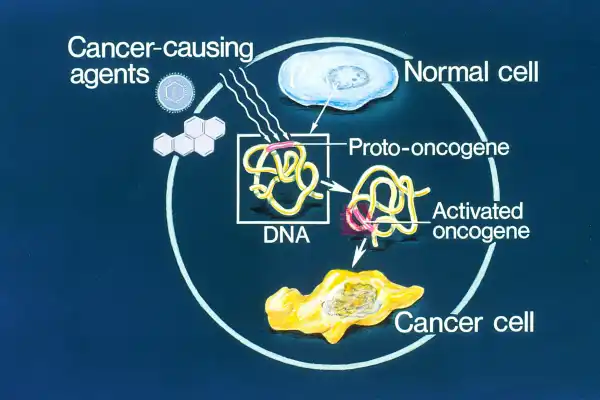
In their non-mutated state, everyone has genes which are referred to as proto- oncogenes.
When proto-oncogenes are mutated or increased in numbers due to DNA damage, the proteins produced by these genes can affect the growth, proliferation, and survival of the cell, and potentially result in the formation of a malignant tumor.
Choice A is incorrect because mutations in oncogenes do not always result in the inhibition of cell division.
Instead, they can contribute to the development of cancer by affecting cell growth.
Choice B is incorrect because oncogenes are not only found in human cells but can be present in other organisms as well.
Choice C is incorrect because genes that regulate cell division can be found in viruses. -
Q #10: What is the normal flora?
A. A variety of microbial species found in certain areas of the human body.
B. A group of infectious parasites that cause diarrheal diseases.
C. The genetic material of bacteria housed within a true nucleus.
D. The protein coat surrounding the viral genome.
Answer Explanation
The normal flora refers to the microbial community that colonizes on the skin and mucus membrane .
Normal flora can be found in many sites of the human body including the skin, respiratory tract, urinary tract, and the digestive tract.

Choice B is incorrect because normal flora does not refer to a group of infectious parasites that cause diarrheal diseases .
Choice C is incorrect because normal flora does not refer to the genetic material of bacteria housed within a true nucleus .
Choice D is incorrect because normal flora does not refer to the protein coat surrounding the viral genome .
Free Access on TEAS 7 Exams and Study Notes
- Access to all TEAS 7 Exams
- Performance Tracking and Analysis
- Well Documented and Explained Questions and Answers
- 2000+ Questions and Correct Answers: Answers Well Explained
- Libary of Detailed StudyNotes
- Topical Questions and Answers on Examinable topics
TEAS 7 Exams (Q&A)
TEAS 7 Study Notes
TEAS 7 Topical Tests

TEAS 7 Study Guides
Quick Links
Refer a Friend
Refer a friend and claim free unlimited access

© 2024 ExamGates Made with by ExamGates
